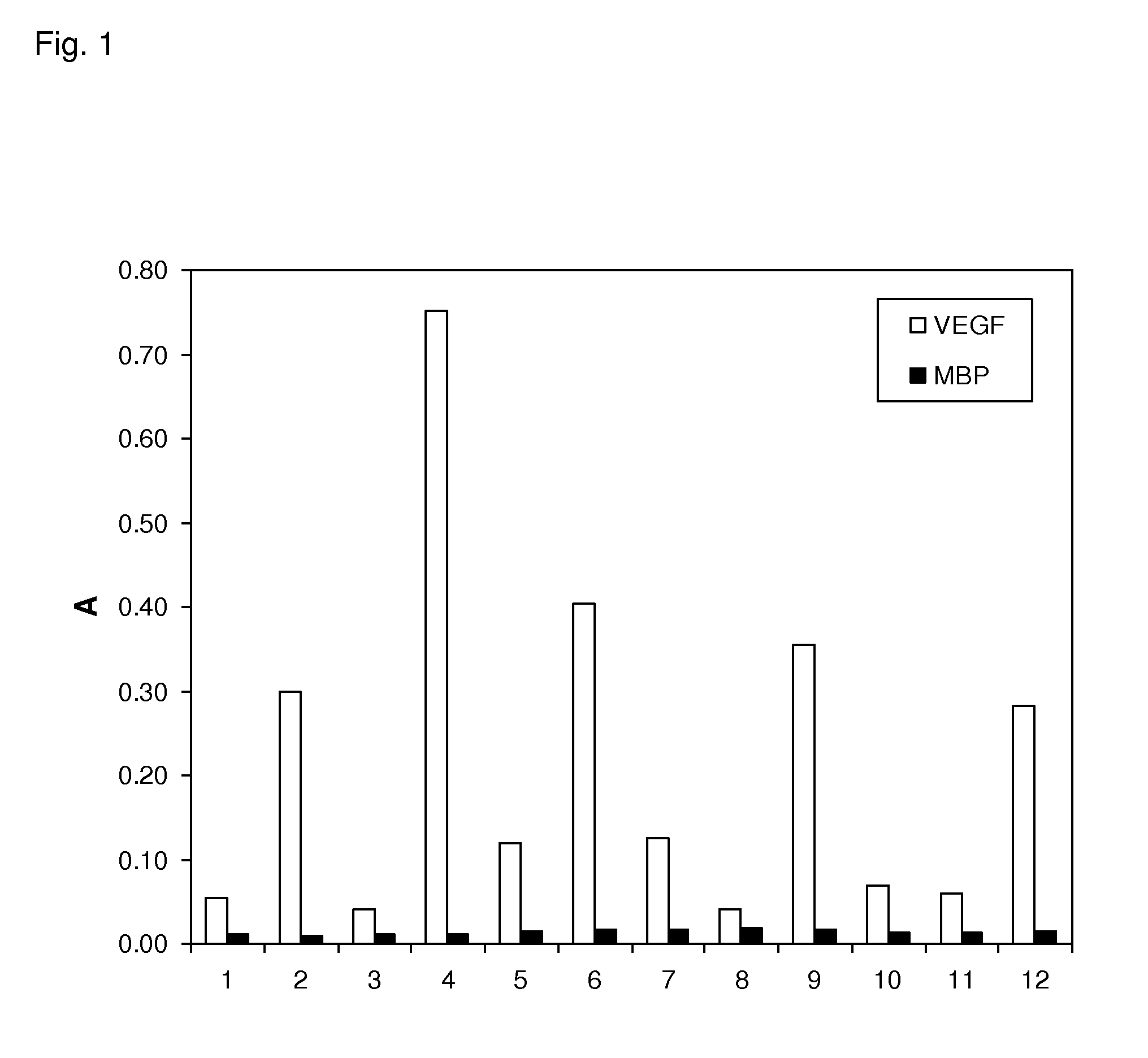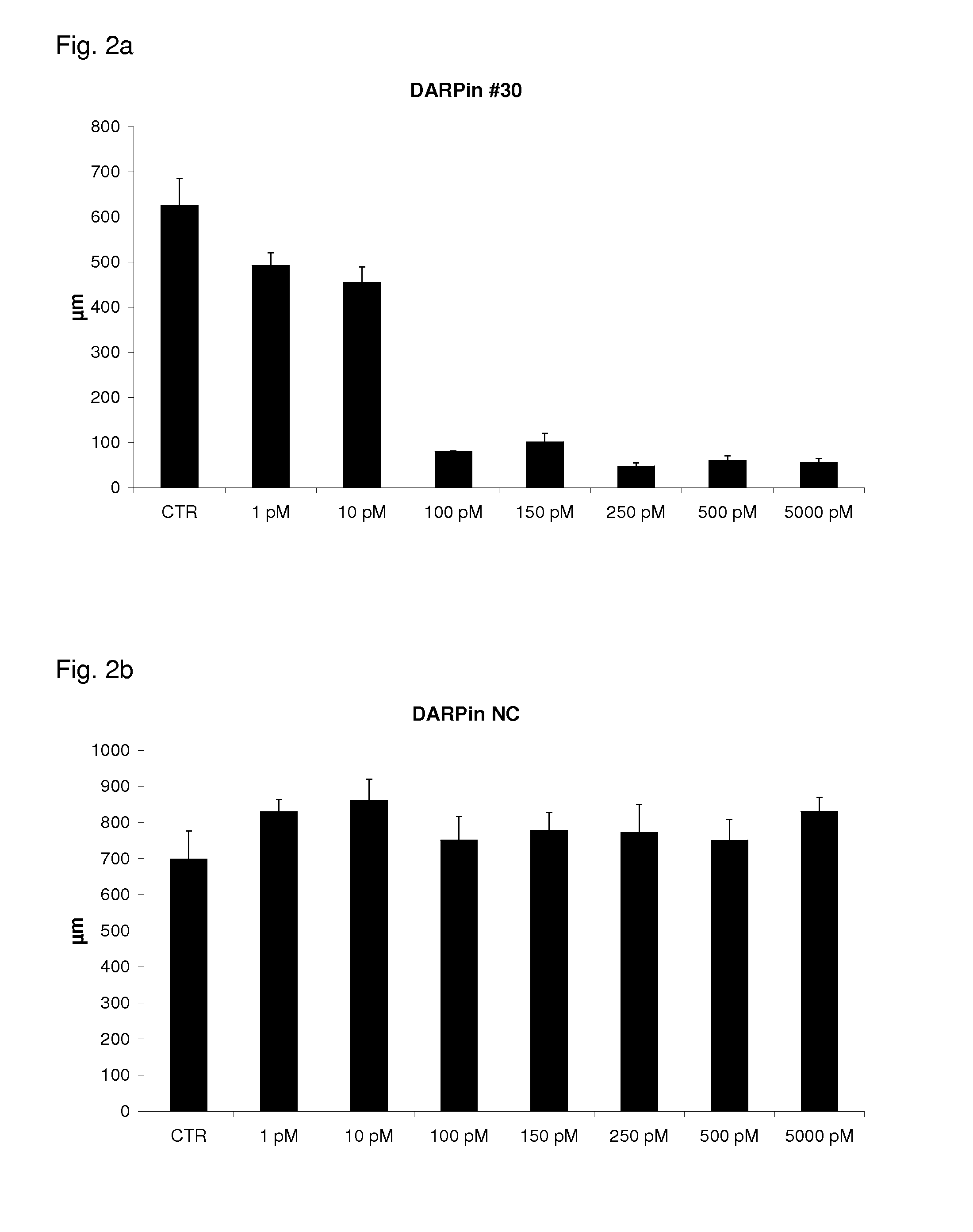Binding proteins inhibiting the vegf-a receptor interaction
a technology of binding proteins and receptors, applied in the direction of angiogenin, peptide/protein ingredients, peptide sources, etc., can solve the problems of complex therapeutic benefits associated with vegf-a targeted therapy, ineffective treatment of vegf-a with currently available therapeutics, and cytotoxicity and dose-limiting side effects, etc., to inhibit the binding of vegf-axxx
- Summary
- Abstract
- Description
- Claims
- Application Information
AI Technical Summary
Benefits of technology
Problems solved by technology
Method used
Image
Examples
example 1
Selection of Binding Proteins Comprising a Repeat Domain with Binding Specificity for VEGF-Axxx
[0143]Using ribosome display (Hanes, J. and Pluckthun, A., PNAS 94, 4937-42, 1997) many designed ankyrin repeat proteins (DARPins) with binding specificity for VEGF-Axxx were selected from the N2C or N3C DARPin libraries described by Binz et al. 2004 (loc. cit.). The binding of the selected clones toward specific (VEGF-Axxx) and unspecific (MBP, E. coli maltose binding protein) targets was assessed by crude extract ELISA indicating that VEGF-Axxx binding proteins were successfully selected (FIG. 1). SEQ ID NO:14 to 40 constitute amino acid sequences of selected binding proteins comprising a repeat domain with binding specificity for VEGF-Axxx. Sequence analysis of selected binders revealed specific ankyrin repeat sequence motifs inherent to certain selected families of binders. Such ankyrin repeat sequence motifs present in repeat domains with binding specificity for VEGF-Axxx are provided...
example 2
Determination of IC50 Values of Selected DARPins with Binding specificity to VEGF-Axxx in a Spheroid Outgrowth Assay
[0151]Addition of VEGF-Axxx to HUVEC spheroids embedded in collagen matrices leads to spheroid sprouting. Addition of an inhibitor of VEGF-Axxx will block sprout formation, which can be quantified statistically by the numbers and lengths of sprouts. By adding different concentration of inhibitor and a constant amount of VEGF, the IC50 can be determined.
Inhibition of Spheroid Sprouting by VEGF-Axxx Specific DARPins
[0152]Spheroid outgrowth assays were done according to standard protocols (Korff et al., loc. cit.). DARPins with specificity for VEGF-Axxx were selected and purified to >96% purity as described in Example 1. Human umbilical vein cells were grown to confluency in monolayer culture. After trypsinization, the cell suspension was placed in a hanging drop to form spheroids, i.e. approximately 500 organized aggregated HUVECs. Spheroids were embedded in a collagen m...
example 3
Determination of the Target Specificity of DARPin #27 in Comparison to Avastin® by Surface Plasmon Resonance Analysis
[0154]Dog VEGF-A164 or Dog VEGF-A164b were immobilized in a flow cell and the interaction of DARPin #27 (SEQ ID NO:16) and Avastin® with the immobilized targets were analyzed.
Surface Plasmon Resonance (SPR) Analysis
[0155]SPR was measured using a ProteOn instrument (BioRad). The running buffer was 20 mM HEPES, pH 7.4, 150 mM NaCl and 0.005% Tween 20. About 1200 RU of dog VEGF-A164 or dog VEGF-A164b were immobilized on a GLC chip (BioRad). The interactions were measured at a flow of 60 μl / min with 5 min buffer flow, 100 seconds injection of Avastin® or DARPin #27 at a concentration of 250 nM and an off-rate measurement of a few minutes with buffer flow. The signal of an uncoated reference cell was subtracted from the measurements.
[0156]The results are shown in FIG. 3a (Avastin interaction with dog VEGF-A164), FIG. 3b (Avastin interaction with dog VEGF-A164b), FIG. 3c (D...
PUM
| Property | Measurement | Unit |
|---|---|---|
| Tm | aaaaa | aaaaa |
| concentrations | aaaaa | aaaaa |
| Tm | aaaaa | aaaaa |
Abstract
Description
Claims
Application Information
 Login to View More
Login to View More - R&D
- Intellectual Property
- Life Sciences
- Materials
- Tech Scout
- Unparalleled Data Quality
- Higher Quality Content
- 60% Fewer Hallucinations
Browse by: Latest US Patents, China's latest patents, Technical Efficacy Thesaurus, Application Domain, Technology Topic, Popular Technical Reports.
© 2025 PatSnap. All rights reserved.Legal|Privacy policy|Modern Slavery Act Transparency Statement|Sitemap|About US| Contact US: help@patsnap.com



